January 2003 (Part 3)
SELECTION OF QUESTIONS AND ANSWERS
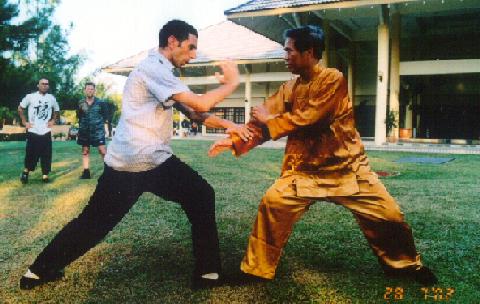
Sifu Wong and Javier Galve demonstrating a Taijiquan San Shou during the Special Taijiquan Course in July 2002 in Malaysia. Here Sifu Wong has just lowered his stance to avoid Javier's palm attack using the Taijiquan pattern, “Green Dragon Shoots Pearl”.
Question 1
Do you have any plans to retire in the near future? Do you have a chosen successor? What are your plans for Shaolin Wahnam Institute?
— Vince, USA
Answer
I want to retire as early as I can, but presently I may not be able to do so for another few years because I have not completed my duty as required by our tenth Shaolin Law to pass on the Shaolin arts to deserving disciples so that they can pass them on to posterity.
I am glad that some of my disciples, like Kowi Beng, Roberto, Javier, Laura, Ricarrdo, Luis, Antonio, Dan, Andrew and Jeffrey, are now teaching. They will help to speed up my retirement plan.
I want to have many successors, not just one. I have not decided on who will head Shaolin Wahnam on my retirement, but will do so if and when the need arises.
Originally we wished to build a Shaolin Temple, or a few Shaolin Temples in various parts of the world, to preserve and teach the Shaolin arts that were taught in the Shaolin Temples in China in the past. We wanted to train enough masters before building the Temples. However, as we are lay disciples and not monks, we may call our buildings “Shaolin Wahnam Centres” instead of “Shaolin Temples”.
We in Shaolin Wahnam are committed to preserve and pass on the genuine Shaolin arts, not just to anyone but to deserving students. One of our cherished hopes is to help the Shaolin Temple in China, if the authority controlling it so desires, to restore the Shaolin arts, so that, amongst other things, the Shaolin Temple will teach Shaolin Kungfu where exponents can spar or fight with typical Shaolin skills and techniques, instead of teaching wushu where modern Shaolin monks and their students spar like boxers or kickboxers.
We also hope to help kungfu exponents, irrespective of their styles, to restore the respect and efficiency of kungfu as a martial art. Now when you tell someone that you practice kungfu, he often replies with a sneer, “Oh, I see, you practice kungfu”, which actually means “Oh, I see, you're a gymnast or dancer. If I give you a kick, you won't know what to do.”
We are sincere in our objective. Those who learn from us, are free to use our skills and techniques in their own arts. They need not even mention that they have learnt from us, if they don't want to. But we require that they follow and practice the Ten Shaolin Laws.
I would like to emphasize categorically that we never claim that if one uses Shaolin Kungfu he will always be victorious in combat. We can be beaten by exponents of karate, taekwondo, Western Boxing or any other martial arts or other kungfu styles. But we are sure that, win or lose, we shall use typical Shaolin (or Taijiquan, for those who learn Taijiquan from me) skills and techniques in combat, and fight honorably, worthy of our Shaolin (or Taijiquan) tradition.
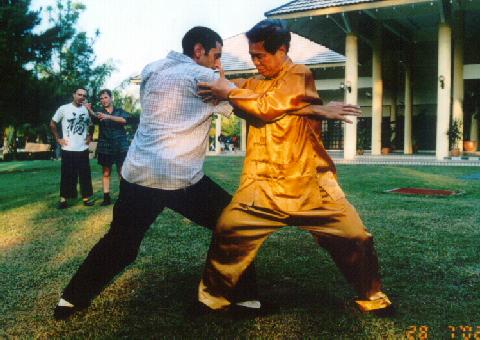
Sifu Wong moves his font leg a small step forward behind Javier's front leg, and simultaneously with his left hand grips Javier's right upper arm near his right shoulder while gripping the remaining arm with his left elbow, and with his right hand grips Javier.s left upper arm near his left shoulder. In the background Roberto and Anthony Spinicchia are discussing the application. Anthony points out how Sifu Wong grips Javier's arms
Question 2
Do you have any disciples or inner-chamber disciples? Are Dan and Anthony inner-chamber disciples? What criteria do you select them by? Can anyone apply to be a disciple? Do you have many?
Answer
In terms of absolute number, I am blessed with many inner-chamber disciples, but in terms of proportion to the total number of my students, I have only a few.
Contradictary to what most people may think, a major concern of many masters is worrying whether their students can progress fast enough to become inner-chamber disciples to succeed them.
Many people may also be surprised that the length of study is not a major criterion for a student to become an inner-chamber disciple. My sifu, Sifu Ho Fatt Nam, told me a few times, “Hok mo cheen hou, tat che wai seen”, which means “It doesn't matter who began first and who later, the one who reaches the destination is the earlier.” Some have learnt with me for 20 years and remain to be students, while some may become inner-chamber disciples after two years.
It is really a joy to have inner-chamber disciples. For me it fulfilled what my sifu, Sifu Ho Fatt Nam, told me to do, and probably what my other sifus would have wanted to though they did not tell me directly, i.e. transmitting the genuine Shaolin arts to deserving disciples. (Note: the term “genuine” was from my sifu, and he emphasized it when he gave me that duty. In Chinese it is “cheng-choong”, literally “genuine-traditional”.)
Yes, Dan and Anthony are my inner-chamber disciples. Like my other inner-chamber disciples, they are selected to attend my Special Shaolin Kungfu Course to be held later this year. This course is by invitation only, and will not be announced publicly.
My Taijiquan inner-chamber disciples had a Special Taijiquan Course last year. I am very proud of them. During the course, they achieved what traditional Taijiquan masters recorded in their classics as advanced Taijiquan skills, like explosive force, response by sensing without seeing, and using mind to direct movements.
There are no hard and fast rules or division of time how or when a student becomes a disciple. Becoming a disciple is not through application. The process is gradual, and often subjective in nature. We cannot tell at what particular point of time that happens, or what stated criteria he has fulfilled. But basically he must be good in character, has attained a reasonable high standard in his training, and practices the ideals of our school.
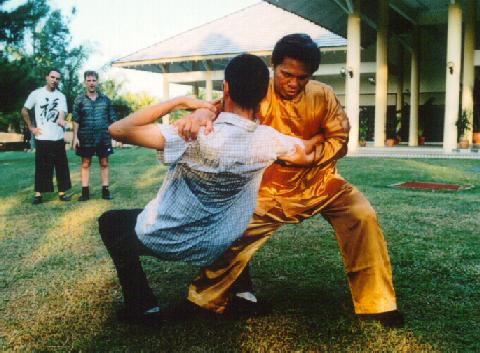
With a twist Sifu Wong throws Javier onto the ground. In an actual combat, Sifu Wong's right hand would be gripping Javier upper arm to prevent him from using this hand to counter attack. Here Sifu Wong has moved his grip onto Javier's shoulder to control the fall so as not to hurt Javier. Notice that in his attack, Sifu Wong has covered himself sufficiently so that it is difficult for Javier to counter-attack.
Question 3
I have personally witnessed, through video footage, Bruce Lee's famed one-inch punch. How could Bruce Lee accomplish this feat without the use of chi kung? It was well known that Bruce Lee favored “water-buffalo” training over soft, internal energy cultivation, and this was quite obvious by looking at him with his shirt off. So how could he have possibly created the force when, according to internal martial arts philosophy, some of his chi meridians were obstructed?
Answer
Force can be developed through many means. Chi cultivation is only one approach. A practitioner can also develop tremendous force by external training, like what Bruce Lee did. I am not familiar with this type of training, and therefore not in a position to explain how it can generate so much force. Instead I would take this opportunity to explain its limitation from the chi kung point of view, as this will be helpful to those who train externally.
External force is limited in its spread and function. Bruce Lee's tremendous force, for example, is limited to his muscles in its spread, and limited to punches and kicks in its function. He could not, for instance, channel his force to his internal organs to nourish them, or to his mind for intellectual pursues. One trained internally can do all these things, and more.
Another serious limitation of external training is energy blockage. Actually this is due to incorrect external training. If a practitioner trains correctly although his approach is external, he can be healthy and still have force. But the nature of external training, like using machines and weights, is such that it is easy for the practitioners to make mistake without knowing them. This was the case with Bruce Lee, and sadly, it led to his early death.
Three obvious limitations of external training are age, sex and size. An elderly person, a woman, a small-sized exponent will be less powerful than their younger, male and bigger counterparts. Had Bruce Lee lived to eighty, he would not be as powerful as when he was thirty.
But these limitations do not apply to internal training. The Shaolin grandmaster Ng Mui, who was the teacher of Yim Wing Choon, the patriarch of Wing Choon Kungfu which Bruce Lee learned, was a classic example. Ng Mui was elderly, female and small-sized, but she was extremely powerful, and in my opinion many times more powerful than Bruce Lee himself.
Question 4
I know you've mentioned that in comparison to yourself a Shaolin monk of 300 years or so ago, was much more powerful. If a Shaolin monk of yore could become so powerful from practicing chi kung first then kung fu etc, how is it that none of your students have surpassed you yet? Why would they continue to train with you, why not teach. But I'd really like to know how exactly a Shaolin monk of yore would be able to surpass someone such as you, who claims such incredible things.
Answer
My students and disciples are not as powerful and skilful as I am because I have spent more than 40 years training, whereas they have spent less than 10. Some of them have trained for only a year or two.
If we reverse the question, it may be more helpful to many people. Why are my students and disciples who have spent only a year or two training with me, more powerful and skilful than others who have spent twenty years of training? I do not mean to be boastful or belittle other systems. Actually many people, including my students themselves, have asked me this important question, and I am sure other people would like to know the “secret”.
My disciples, like Emiko and Dan who have trained with me for about two years, recently found out to their surprise in sparring that they were more powerful and skilful than some martial art masters who have practiced and taught for more than twenty years!
I am saying this fact in good faith, but if you or any reader do not believe me and feel that I am boastful, I am sorry, in which case, please regard me as talking rubbish. For those who wish to know, the answer or “secret” is, to put it crudely but aptly, my students use smart methods, whereas the others use water-buffalo methods.
Smart training involves many factors. One important factor is to have vision and direction, which means you know what the destination is and how to get there. Another important factor is cost-efficiency, which means choosing the best available method to achieve maximum result in minimum time. For example, if my objective is to develop internal force, I would practice “Golden Bridge”. If my objective is to develop speed and agility, I would practice Self-Manifested Chi Movement instead.
Water-buffalo training is characterized by “no pain, no gain”. Another characteristic is that there is much irrelevance and wastage, often due to their lack of insight into what is being trained. For example, to develop force, students carry weights or punch sandbags relentlessly, not because these are good methods but often because they have no other choice. They push themselves to their limits, training hard and rough for two hours when 15 minutes would bring maximum result.
Not only they waste time, they hurt themselves by depleting their energy and overworking their internal organs. When they have developed big muscles and calloused hands, besides tension and pain, they discover they are not so powerful after all when compared to those who train internally, although they may look tough and rough. At the end of twenty years of training, they find they are not much stronger than when they were at their second year.
Your asking “why would they continue to train with you, why not teach” implies that you believe once you have attained a sufficient high level to teach others, you can forget your own teachers. This attitude is not only disrespectful to your teachers, but also unhealthy for you. Even if you have surpassed your teacher, you can still learn and benefit from him. And most important, you must continue to honour and respect him.
There are many reasons why my students and disciples continue to learn from me. One important reason, which you may find hard to understand or believe, is their sincere respect and gratitude for me. I have told a few students and disciples, those who repeat my same courses frequently, that they need not attend the courses, that they can practice on their own. They told me — much more in their feeling than the words they spoke — they just want to be in my class.
When I said that I was nowhere compared to the Shaolin monks of yore, I was not being modest, I was being honest. My sifu, Sifu Ho Fatt Nam, said the same thing, and I am really nowhere near my sifu. I am, at best, a master of energy; my sifu was a master of mind. You thought my claims impossible, and slandered me behind my back, but you would be shocked if you heard what my master had actually done.
You and many people, including many modern Shaolin monks, do not realize or do not believe the incredible scope and depth of the Shaolin arts. How do I know that? It was obvious from their actions, and from their students' words in their discussion forum. To be a monk, specially a Shaolin monk, marked one of the highest point of a person's development, enabling him to be free from all mundane cares and duties so that he could totally focus on attaining the greatest achievement any being can ever achieve, i.e. Enlightenment.
What am I when compared to such a highly developed spiritual being, albeit in a human body, ready and actually on his way to attain the highest fulfillment? No matter what I may achieve in kungfu or chi kung, it is still in our mundane world, although occasionally I may have majestic glimpses of cosmic reality, reassuring me the most noble potential in store when I am ready. The Shaolin monk of yore was already there, ready to jump beyond the three realms of countless existence to attain Eternal and Infinite Bliss.
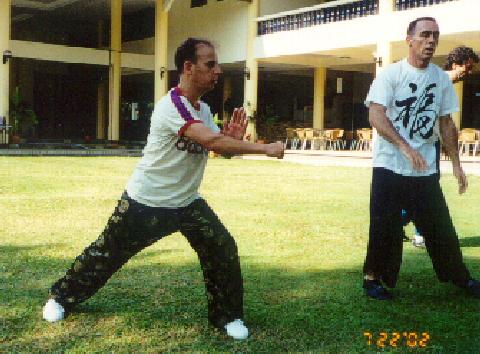
This picture shows Sifu Wong's inner-chamber disciples at the Special Taijiquan Course in July 2002 in Malaysia practicing the skill of using mind to direct form. Here Angel has just completed this task, using his mind to direct a vertical punch in the pattern “Punch Below Sleeves”. Notice that his eyes are gently close so as to focus better.
Question 5
I am very sincere about training with you and that there is no place on earth I wouldn't travel just to meet you, that's how much you've changed my life. But something that has interested me for awhile is that you don't teach in the United States of America. I'd like to know why this is so. I know you teach in Canada, but I was just wondering whether Canada is a personal preference of yours or is it because you have more students in the area?
Answer
I have taught in the United States in private, but not in public classes as in other places. Where I taught was not a personal preference, but a response to sincere invitation. My policy is to teach only when students request me to, and when they are deserving. A well known organizer who has organized seminars for many established masters has invited me to teach in the United States, but due to my tight schedule, it will probably be in 2004.
Your intention to learn from me contrasts sharply with your frequent slandering and insulting me behind my back. Right now you are not qualified to be my student because you were disrespectful not only to me, but also my disciples and the ideals we stand for. You even insulted my family. This is against the first Shaolin Law. But you have shown some positive changes, and you spoke kindly of me in some recent discussions. Hence, if you sincerely repent I may reconsider your case when you actually apply to learn from me.
You would be pleased to know that in terms of benefiting from a master (any master) you are better of than another group of people. There are two groups of people masters wound not like to teach — one, those who are disrespectful; two, those who know a little but think they know a lot, and close themselves to further learning.
Once disrespectful people realize their mistake and become sincere and respectful, they often turn out to be very good students. Those from the second group are often incorrigible. Masters would not want to waste time on them.
You may sneak into one of my regional classes, or even my intensive courses, to learn from me without my knowing, but that will be dishonorable, and as you aspire to become a Shaolin disciple, you should not do that.
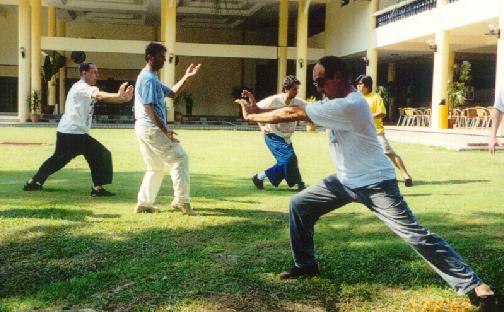
Some of Sifu Wong's inner-chamber disciples using energy flow, instead of muscles, to perform various Taijiquan movements at the Special Taijiquan Course. From left: Roberto, Ricarrdo, Jorge, Attilio and Chun Nga (partly hidden).
Question 6
Why do you think that the people who were affected by your transmission of chi reacted like panthers and so on?
— John, Australia
Answer
When the energy in our various internal organs flows vigorously, the various types of energy are manifested in numerous ways. The heart energy manifests as a bird, the liver energy as a deer, the spleen energy as a monkey, the liver energy as a tiger, and the kidney energy as a bear.
This does not mean that when you have a lot of heart energy, you become a bird, or when you have a lot of kidney energy, you become a bear. But the vigorously flowing of the various types of organ energy causes certain emotional and physical reactions. Chi kung masters in the past generalized these different reactions into five archetypes, using the bird, the deer, the monkey, the tiger and the bear to symbolize them.
Different types of organ energy may be flowing at the same time in different combinations, thus adding variety to the movements. The chi movements are also affected by other factors, such as the mental state as well as the bodily needs of the persons involved.
Thus, when the people received my energy transmitted to them from afar, they reacted differently. One moved like a panther, one walked like a duck, and others moved in different ways.
(Note: John asked about the reaction of the people during a demonstration of distant chi transmission at the Second World Congress on Qigong in San Francisco in 1997.)
Question 7
Since you are capable of manipulating chi, is distance attack (non-physically) possible?
Answer
Yes, it is possible, though many people may find it hard to believe. If they remind themselves that radiation from huge generator or power lines can be harmful, it may not be too difficult to believe energy transmitted by a powerful master, which can be compact, focused and explosive, can hurt.
In the world of kungfu, there are three arts known as the ultimate. They are Shaolin Marvelous Fist, Strike-Across-Space Palm, and One-Finger Zen. All these are Shaolin arts, and all of them are executed by masters with powerful energy and powerful mind, capable of injuring opponents from a distance.
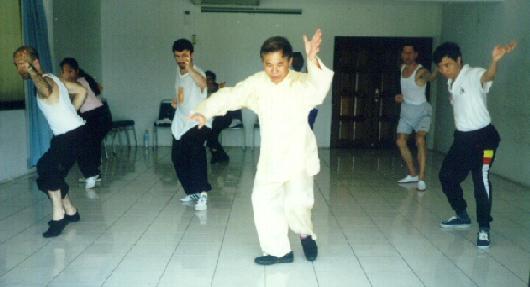
Sifu Wong practicing a Shaolin kungfu set with his inner-chamber disciples at an Intensive Shaolin Kungfu Course in Malaysia. From left: Anthony Korahais, Emiko, Jeffrey, Sifu Wong, Douglas and Kwoi Beng.
Question 8
I've recently been studying Chinese martial arts, although, my background is Taekwondo. Do you suggest I should start with an external style or an internal style of kungfu? My favourite is Taiji.
— Nguyen, USA
Answer
I would suggest you start with an internal style. Many external martial artists, including those who practice Taekwondo, sustain a lot of internal injuries. Their injuries were caused not just by sparring; their solo practice itself caused much energy blockage which can lead to physical and emotional illness.
Practicing an internal art which pays attention to energy flow will help to clear the blockage, enabling you to return to good health. Only when you have good health would you consider combat efficiency. This is a basic philosophy in Chinese martial arts, especially in Shaolin Kungfu and Taijiquan, and this contrasts sharply with non-Chinese martial arts, such as Karate, Taekwondo, Muay Thai, Kickboxing and Western Boxing, which often sacrifice health for combat efficiency.
As your favourite is Taiji, that would be excellent. But I would suggest you practice Taijiquan, and not Taiji. According to my definitions, Taijiquan is an internal martial art, but Taiji is some sort of dance using external Taijiquan forms. It is not common to find Taijiquan today, so if you can't find a Taijiquan school to learn from, even learning Taiji may serve to provide the soft dimension to your hard Taekwondo. You would, however, not be able to use Taiji for self-defence, in which case your Taekwondo would be useful.
Question 9
If an external style is more efficient, what do I need to learn to get the fundementals of kungfu? If Taiji is more efficient, what can I do to improve my techniques and skill?
Answer
If you are unable to learn genuine Taijiquan or any other genuine internal martial art, choosing an external style of kungfu, like Praying Mantis, Eagle Claw, Hoong Ka, Choy-Li-Fatt or Wing Choon, is better than training Taekwondo or any other external non-Chinese external martial art like Karate, Kickboxing or Western Boxing. This is, of course, my opinion.
The main reason is that you do not hurt yourself. I am referring to these styles as genuine kungfu, i.e. you can defend yourself. But if they are just external forms, or what I would call kungfu gymnastics, then you would have to choose between practicing Taekwondo where you can defend yourself but you are likely to sustain injury in your training, or practicing kungfu gymnastics where self-inflicted injury is unlikely and you can perform beautiful forms but you cannot defend yourself.
You may, as many people do today and which Bruce Lee did to an excellent level, combine the beautiful forms of kungfu gymnastics with the sparring of Taekwondo. The result will be a hybrid. It is something that I would not recommend, though it is probably the most practical course of action to most people. Ironically, due to their narrow perspective and limited exposure, some of them honestly think they are improving kungfu, or improving Taekwondo, even claiming they have brought kungfu to a new dimension with their innovation to meet changing times.
The best course of action I recommend is to seek a genuine Taijiquan or Shaolin master and learn from him. If you want the best, of course, you must be ready to make sacrifice, but the rewards are overwhelming more than the money, effort and time you invest.
If we are speaking about genuine kungfu, irrespective of whether it is an external style or an internal style, the fundamentals include stance training to develop force and practicing techniques for self defence. Force training and combat efficiency are the two most important aspects of all styles of kungfu. The difference between external and internal styles, and between high level and low level kungfu, lies in their approach and attainment.
Logically, external styles approach the two fundamentals using relatively hard and external methods, whereas internal styles use gentle and internal means. High level kungfu achieve good results in a short time whereas low level kungfu achieve little even after long periods. This is so obvious, yet many people, due to ignorance, stubbornness, prejudice or other factors, are blind to such simple facts. For example, they insist that their art is kungfu when they cannot defend themselves at all, or they claim their art to be of high level when despite training for many years they are still stressful and in pain.
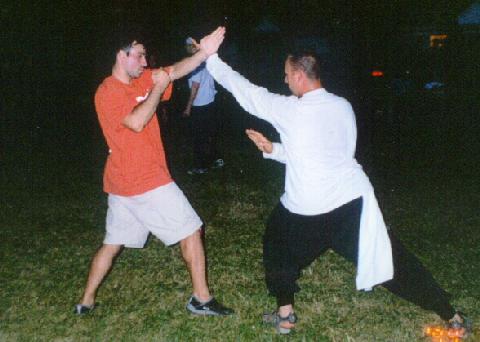
Another two of Sifu Wong's inner-chamber disciples, Eugene and Anton, practice sparring during a regional Shaolin Kungfu Course in Toronto in July 2002. Eugene attacks with a palm chop using a pattern called “Chop the Hua Mountain”, and Anton responds with a “threading” technique using a pattern called “Green Dragon Plays with Water”. Notice that stances are very important in kungfu sparring.
Question 10
How can I sense attacks, improve my speed; and improve power?
Answer
Different arts use different methods. Most arts use separate means to accomplish separate objectives. For example, to learn sensing attacks, a practitioner may blindfold himself and ask a partner to attack him. To improve speed, he may discard his forms and stances and fight like a boxer. To improve power, he may lift weights or punch sandbags.
These are common methods, and from the perspective of genuine Taijiquan and Shaolin Kungfu, are considered mediocre methods. In these methods the practitioner has no insight into his training, and often is confused between cause and result. For example, to be able to defend himself even when blindfolded is the result, not the cause, of his training to sense attacks. Discarding his forms and stances to fight like a boxer is due to his lack of understanding that his art and boxing are different in nature and function.
In high level kungfu, sensing attacks, improving speed, improving power and other skills are developed holistically, and are integrated into basic form training, although there are also special techniques to enhance these skills separately. In other words, by practicing a Taijiqjuan or Shaolin set, or by practicing one Taijiquan or Shaolin pattern repeatedly, a practitioner can develop his ability to sense attacks, improve his speed and power, as well as enhance other skills. It is difficult for the uninitiated to understand or even to believe, but it is true.
For example, the Taijiquan patriarch Yang Lu Chan practiced just “Grasping Sparrow's Tail” thousands of times everyday. He did not blindfold himself for a partner to strike him, he did not bounce like a boxer, and he did not lift weights or punch sandbags, yet he could sense opponents ambushing him from behind, he was fast enough to fight twenty people at one time, and he could fell a massive brute with just one strike.
Actually Yang Lu Chan did not just practice “Grasping Sparrow's Tail”. He used “Grasping Sparrow's Tail” to train form, energy and mind. When his physical form is fluid, his energy abundant, and his mind powerful and focused, he would be more perceptive, faster and more forceful than anyone who employs only physical means in his training.
